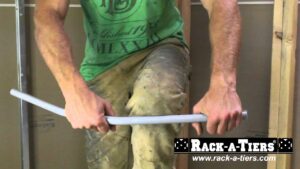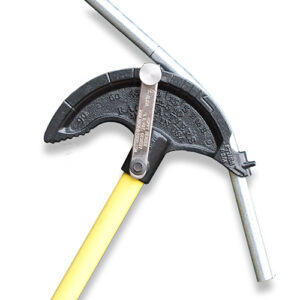How To Bend PVC Conduit
What is PVC conduit? Polyvinyl chloride is the preferred conduit type for direct burial installations of electrical wire. PVC conduit is not to be confused with PVC pipe, as both are used for different applications. The most used type of PVC conduit in our industry is known as schedule 40, which refers to the thickness of its walls. Because not every installation is created with straight runs, how does one bend this type of material? Unlike EMT, (Electrical Metallic Tubing), the PVC conduit must be heated in most instances for it to be bent.
What is the best PVC Conduit Bending Technique?
Pre-Bent Angles
In the electrical trade, two options exist for tradesman bending this type of material. The first is purchasing manufactured pre-bent angles such as 90’s, 45’s, 30’s, etc. The alternative is to use a heat gun allowing the PVC to reach a temperature that allows it to be manipulated freely. The most common factors that determine which method you decide on will be the size of your PVC conduit and the type of bend needed for the installation. PVC conduit under 2″ is easier to heat up and bend than 4″ PVC conduit.
You can purchase manufactured bends for PVC conduit at any retail store like Home Depot in the same aisle as the PVC conduit. When purchasing these bends, keep in mind the size and schedule of your PVC conduit. When buying manufactured bends such as 90-degree bends it’s common to use a sweep 90. These will have a larger bend radius which makes the wire easier to pull wire afterward.
Add Some Heat

The other technique for bending PVC conduit is using a heating tool, such as a heat gun. You do this by using your heat gun/tool to heat up the desired location of your bend until the PVC becomes malleable. Once the PVC conduit becomes malleable, hold it in the desired position for the application. It is important to note that once PVC conduit heats up, cooling it down can become time-consuming. So come prepared with a spray bottle filled with cool water, a wet rag, or a water hose.
Once the PVC conduit has cooled, check your bends to ensure that it is what you need for the installation. If the bend angle isn’t quite what you want, you can reheat and start the process over. Be wary of repeating it too much as the heating process could eventually cause your PVC conduit to become too brittle.
Best Tools For Bending PVC Conduit?
For many years there were limited amounts of specialty tools for the electrical trade. When it comes to these tools, Rack-A-Tiers definitely has some insider knowledge clearly shown in the practicality and use of their tools. This is also seen in the tools they manufacture for bending PVC conduit.
The Pipe Viper
 The first of these groundbreaking tools from Rack-A-Tiers is the Pipe Viper. This product comes in sizes that range from ½” all the way to 4″ PVC conduit. An innovative feature of this item is that it allows you to cold bend both ½” and ¾” schedule 40 PVC conduit. This means no heat gun is needed to bend those sized conduits.
The first of these groundbreaking tools from Rack-A-Tiers is the Pipe Viper. This product comes in sizes that range from ½” all the way to 4″ PVC conduit. An innovative feature of this item is that it allows you to cold bend both ½” and ¾” schedule 40 PVC conduit. This means no heat gun is needed to bend those sized conduits.
To use this product all you need to do is insert the spring into the pipe & bend it across your knee. The PVC conduit requires slight over-bending which will allow the “pop back,” upon the release of the bending pressure.
The Pipe Viper is one of the most versatile and cost effective tools when it comes to cold bend sizes. It eliminates having to carry a tool with you or having to purchase one if you do not already have it. When it comes to any size above ¾” PVC, heat is required in conjunction with the Pipe Viper to achieve your bend desired.
Check out @justpowerelectric_162 demoing the Pipe Viper here!:
Buy the Heat Tank from Rack-A-Tiers
The Heat TANK
Another product that will be a great addition to your arsenal if you already have a heat gun-is the Heat Tank. The Heat Tank is a metal tank that holds the heat and amplifies the efficiency of the heat gun. It allows the tradesperson to have additional control over the heat applied to the PVC conduit, preventing overheating and burning. It does this with the use of the temperature gauge. This product eliminates the need for a more expensive or heavier heating box. The Heat Tank allows you to heat up PVC conduit up to 1-1/2″ in as fast as 3 minutes. This will allow you to heat up your PVC conduit hands-free and quicker than with a heat gun alone.
Check out @jeremy.parks.10 demonstration of the Heat Tank
Buy the Heat Tank from Rack-A-Tiers
The Hoppy Bender
Another product Rack-A-Tiers has for bending PVC conduit is the Hoppy Bender. This amazing tool is a hand bender that’s available in two sizes, ½” and ¾.” It has a great time-saving feature, the stop attachment. This feature prevents you from going past the bend that it is set at. Another practical feature includes simplified multipliers engraved onto the bender for placing the stop attachment before making offsets, four-point saddles, and special 22.5 and 45-degree bends.
attachment. This feature prevents you from going past the bend that it is set at. Another practical feature includes simplified multipliers engraved onto the bender for placing the stop attachment before making offsets, four-point saddles, and special 22.5 and 45-degree bends.
These marks are engraved onto the bender for placement of bend marks as well as standard degree marks for the stop attachment placement. Another feature is the reference charts attached to the handle for locating bend marks. Bending PVC conduit with the Hoppy Bender requires you to first heat up the PVC by any means of your choice, then bend your PVC conduit to the desired degree. Once the PVC conduit is bent the conduit can be cooled using water or a wet rag until no longer malleable.
Buy the Hoppy Bender from Rack-A-Tiers
There are other means in the field that enable you to bend PVC conduit. However, the ones listed above are the most commonplace techniques used. Most ways to bend PVC will include using some type of heat gun/tool and cooling down process, but how you achieve your bends are numerous. Always take your time when making bends and allow your PVC to properly cool before checking your bend.